Medication relates to personal health; please use it scientifically and reasonably under the guidance of a physician or pharmacist. Do not misuse medications.
This article briefly explains the causes of Kidney Yin and Yang Deficiency and randomly lists several TCM formulas for treating Kidney Yin and Yang Deficiency.
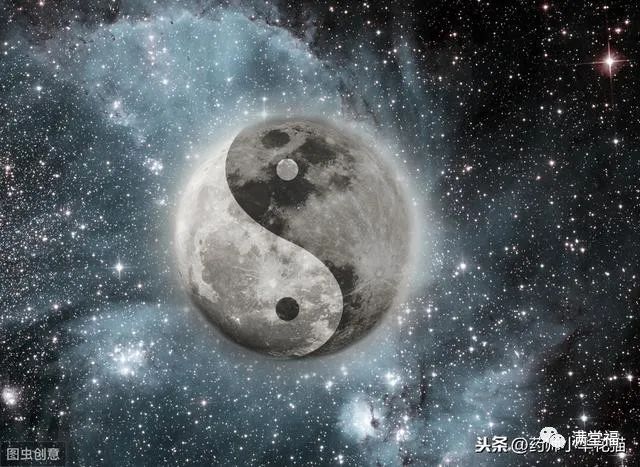
The basic content of the Yin-Yang theory includes the opposition and restriction of Yin and Yang, mutual generation, balance of consumption and growth, and mutual transformation.
To understand Kidney Yin and Yang Deficiency, we must first discuss Yin and Yang:
The Yin-Yang theory is a representation of ancient Chinese materialist philosophy and serves as the foundational theory of TCM. The concept of Yin and Yang will not be discussed in depth here; interested readers can refer to TCM foundational theory books for further understanding. The basic content of the Yin-Yang theory includes the opposition and restriction, mutual generation, balance of consumption and growth, and mutual transformation. In this article, we will only briefly look at the mutual transformation and mutual generation of Yin and Yang.
Mutual transformation refers to “Yin can transform into Yang, and Yang can transform into Yin.” Under certain conditions, Yin and Yang can transform into each other. (Extreme cold generates heat, extreme heat generates cold)
Mutual generation means “Yang is born from Yin, and Yin is born from Yang.” Yin and Yang are interdependent; neither can exist independently. (The loss of Yang or Yin both indicate a critical condition)

Yin and Yang must be interdependent to form a complete life. Isolated Yin or Yang cannot exist independently.
After understanding the mutual transformation and mutual generation of Yin and Yang, let’s return to the topic of Kidney Yin and Yang Deficiency:
Most people know that Kidney Deficiency is divided into two types: Kidney Yin Deficiency and Kidney Yang Deficiency, but few have heard of the condition of both Kidney Yin and Yang Deficiency.
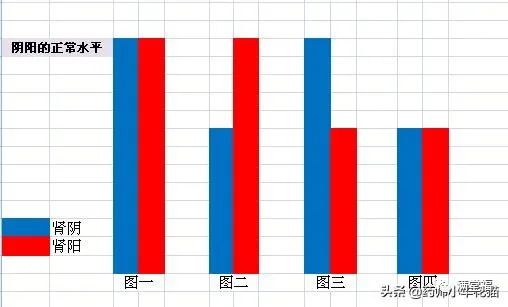
A simple diagram illustrating Kidney Yin Deficiency, Kidney Yang Deficiency, and both Kidney Yin and Yang Deficiency.
The above diagram is a very simple yet clear illustration I created in a table. Through this diagram, we can visually see the normal states of Kidney Yin and Yang and their deficient states; the blue color represents Kidney Yin, and the red color represents Kidney Yang:
Figure 1: Both Kidney Yin and Yang are relatively sufficient, in a full state, with dynamic balance, indicating a healthy state;
Figure 2: Kidney Yang is at a normal level, while Kidney Yin is relatively insufficient and in a deficient state, presenting symptoms of Kidney Yin Deficiency;
Figure 3: Kidney Yin is at a normal level, while Kidney Yang is relatively diminished and in a deficient state, presenting symptoms of Kidney Yang Deficiency;
Figure 4: Both Kidney Yin and Yang are not full, both are depleted, and are below normal states, presenting symptoms of both Kidney Yin and Yang Deficiency.
Of course, this diagram is just a very simple illustration aimed at helping everyone quickly and intuitively understand the state of Yin and Yang. In reality, Yin and Yang are dynamically transforming and maintaining a dynamic balance; the state of Kidney Deficiency is also complex and does not develop according to such a simple and clear pattern.
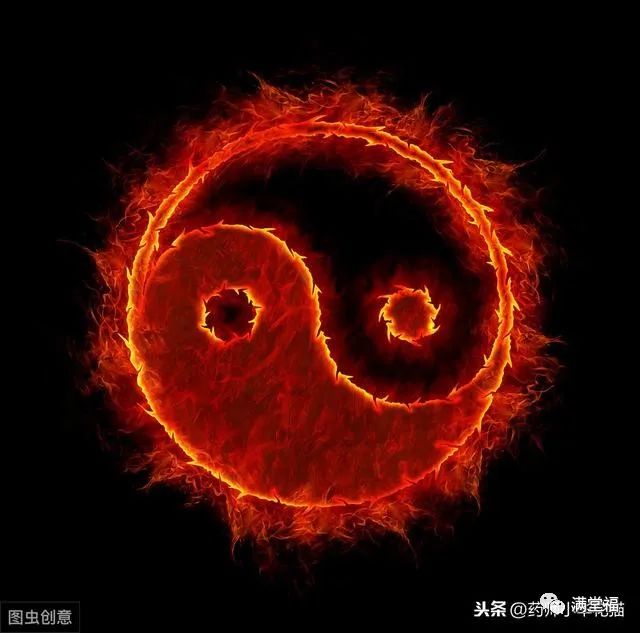
Yang is born from Yin, and Yin is born from Yang; Yin can transform into Yang, and Yang can transform into Yin. The mutual transformation and mutual generation of Yin and Yang achieve dynamic balance, which is a state of health.
The typical characteristic of Kidney Yang Deficiency is “cold”, often accompanied by symptoms such as fatigue, cold intolerance, cold extremities, lower back and knee soreness, soft muscles and bones, clear and frequent urination, lower limb edema, and premature graying of hair. The primary principle for treating Kidney Yang Deficiency is to warm and tonify Kidney Yang.
The typical characteristic of Kidney Yin Deficiency is “heat”, often accompanied by symptoms such as lower back and knee soreness, dizziness, tinnitus, insomnia with vivid dreams, five-center heat, tidal fever with night sweats, premature ejaculation, and dry throat with red cheeks. The primary principle for treating Kidney Yin Deficiency is to nourish Yin and clear heat.
There are many TCM formulas for treating Kidney Yang Deficiency and Kidney Yin Deficiency, which will not be elaborated here.

Typical symptoms of Kidney Yang Deficiency include fatigue, cold intolerance, cold extremities, and premature graying of hair.

Typical symptoms of Kidney Yin Deficiency include lower back and knee soreness, dizziness, tinnitus, insomnia with vivid dreams, and five-center heat.
Causes and Main Symptoms of Kidney Yin and Yang Deficiency:
Causes of Kidney Yin and Yang Deficiency: When the body exhibits symptoms of Kidney Yang Deficiency, if we do not promptly and effectively regulate and treat it, allowing it to develop without intervention for an extended period, the previously mentioned “mutual generation of Yin and Yang” and “mutual transformation of Yin and Yang” will be affected. As Kidney Yang continues to deplete to a certain extent, Kidney Yin will be directly impacted, unable to rely on Kidney Yang for transformation, leading to depletion of essence and Qi in the kidneys, and ultimately evolving into the condition of both Kidney Yin and Yang Deficiency. Similarly, if Kidney Yin Deficiency is allowed to develop without intervention, when Kidney Yin is depleted to a certain extent, it will also affect Kidney Yang, similarly leading to the condition of both Kidney Yin and Yang Deficiency.
Symptoms of Kidney Yin and Yang Deficiency: Cold intolerance with warm palms and soles, curling up due to cold but feeling heat in the five centers, lower back and knee soreness but clear and frequent urination, dry mouth and throat but preferring warm drinks, white coating at the root of the tongue but feeling anxious and restless, etc. Symptoms of Kidney Yin and Yang Deficiency often present as symptoms of both Kidney Yang Deficiency and Kidney Yin Deficiency.
Having briefly clarified the sources and main symptoms of Kidney Yin and Yang Deficiency, let’s look at several commonly used TCM formulas for treating this condition:
1. Shenrong Wan
Function and Indications: Nourishes Yin, tonifies the kidneys, benefits essence, and assists Yang. Used for Kidney Deficiency with cold symptoms, impotence, premature ejaculation, nocturnal emissions, lower back and leg soreness, physical weakness, and deficiency of Qi and blood.
Main Ingredients: Red Ginseng, Rehmannia (cooked), Morinda Root, Dried Tangerine Peel, Cuscuta (roasted), Atractylodes (roasted), Chinese Yam, Honey-fried Astragalus, Poria, Achyranthes, Cistanche (processed), Cinnamon, Angelica, Goji Berries, Deer Antler, Fennel (salted), White Peony (wine-fried), Honey-fried Licorice.
Dosage: Oral administration, 10g/pill, 1 pill at a time, 2 times a day.
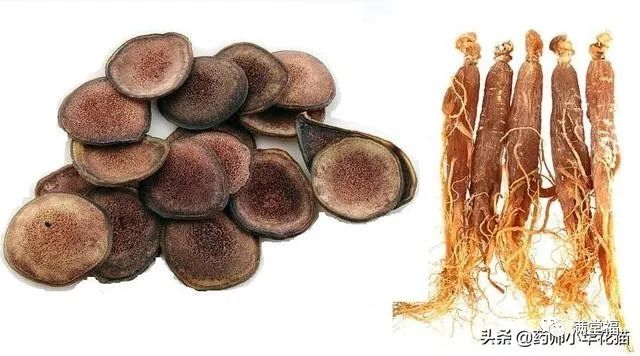
Deer Antler slices and Red Ginseng.
2. Shenrong Sanbian Wan
Function and Indications: Tonifies the kidneys, assists Yang, benefits Qi, and generates essence. Used for Kidney Yang Deficiency and Kidney Yin Deficiency leading to: impotence, nocturnal emissions, dim vision, fatigue, and weakness in the lower back and knees.
Main Ingredients: Epimedium (roasted), Psoralea (salted), Yangqi Stone (calcined), Raspberry, Cherry Flesh, Goji Berries, Achyranthes, Deer Antler, Deer Whip, Dog Whip, Donkey Whip, Cistanche, Chives, Cuscuta, Dipsacus, Rehmannia (cooked), Daqing Salt, Ginseng, Cinnamon, Aconite (processed), Star Anise, Eucommia (charred), Atractylodes (roasted), Rehmannia, Chuanxiong, and Wood Fragrance.
Dosage: Oral administration, 8g/bag, 1 bag at a time, 2 times a day.
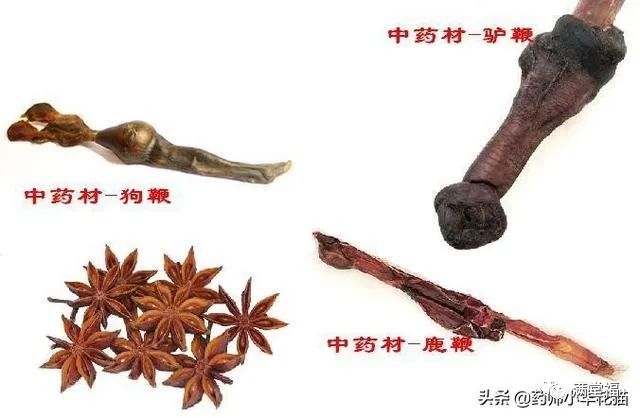
Four types of medicinal materials – Dog Whip, Deer Whip, Donkey Whip, and Star Anise.
3. Shenlu Fuzheng Capsules
Function and Indications: Supports the righteous Qi, nourishes Yin, strengthens Yang, detoxifies, and disperses masses. Used for both Yin and Yang Deficiency causing fatigue, dizziness, forgetfulness, insomnia, lower back and knee soreness, impotence, frequent urination at night, and as an adjunctive treatment for cancer radiotherapy and chemotherapy.
Main Ingredients: Ginseng, Deer Antler Glue, Rehmannia (cooked), Goji Berries, Cistanche, Morinda Root, Fenugreek, Poria, Sea Buckthorn, Schisandra, Acanthopanax, Dipsacus, Achyranthes, Asparagus, Chinese Yam, Sour Jujube Seed, Mulberry, Atractylodes, and Cat’s Claw.
Dosage: Oral administration, 0.35g/tablet, 2-4 tablets at a time, 3 times a day; or as directed by a physician.
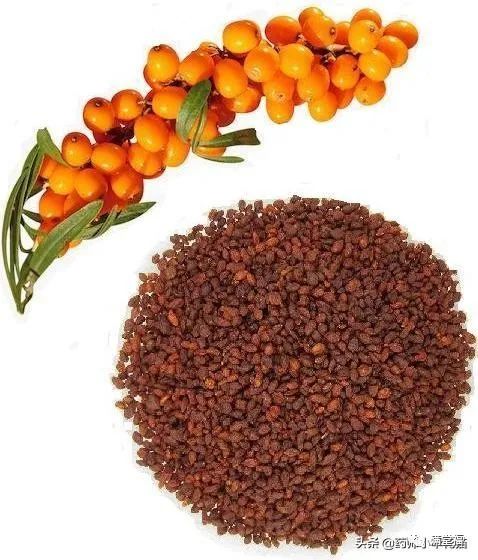
Fresh Sea Buckthorn fruit and dried medicinal material Sea Buckthorn.
4. Tianqi Buxin Capsules
Function and Indications: Tonifies the kidneys, assists Yang, fills essence, and benefits marrow. Used for both Kidney Yin and Yang Deficiency, presenting with lower back and knee soreness, dizziness, tinnitus, fatigue, etc.
Main Ingredients: Seahorse, Donkey Kidney, Dog Kidney, Epimedium, Yangqi Stone, Kidney Tonifying Fat, Xianmao, Cornelian Cherry, Morinda Root, Rehmannia (cooked), Goji Berries, Mulberry, Cuscuta, Lotus Stamen, Fox Nut, Ginkgo, and Chives.
Dosage: Oral administration, 0.4g/tablet, 4 tablets at a time, 3 times a day, taken 30 minutes after meals.

Fresh Mulberry and dried medicinal material Mulberry.
5. Shenrong Buxin Tablets
Function and Indications: Tonifies the kidneys, strengthens Yang, benefits Qi, and nourishes blood. Used for both Yin and Yang Deficiency, presenting with impotence, coldness, nocturnal emissions, and fatigue.
Main Ingredients: Astragalus, Sour Jujube Seed, Schisandra, Acorus, Deer Antler (hair removed), Sand Ginger, Alisma, Angelica, Red Ginseng (hair removed), Cardamom, Dioscorea, Hawthorn, Ginger, Yangqi Stone, Cistanche, Aconite (processed), Poria, Cornelian Cherry, Eucommia, Seahorse, Malt, Radish Seed, Betel Nut, Raspberry, Asparagus, Dog Kidney, Fritillaria, Psoralea (salted), Ophiopogon, Tangerine Peel, Donkey Kidney, Achyranthes, Licorice, Cinnamon (skin removed), Atractylodes, Codonopsis, Cuscuta, White Peony, Goji Berries, Chuanxiong.
Dosage: Oral administration, 12 tablets/pack, 4-6 tablets at a time, 2 times a day.

Medicinal materials – Daqing Salt and Fennel.
6. Seahorse Strong Kidney Pills
Function and Indications: Tonifies the kidneys, fills essence, and strengthens Yang. Used for both Kidney Yin and Yang Deficiency causing impotence and nocturnal emissions, and lower back and knee soreness.
Main Ingredients: Rehmannia (cooked), Fresh Sparrow Meat (head and feet removed), Donkey Kidney, Dog Kidney, Deer Tendon, Dried Seahorse, Aconite (processed), Cistanche (wine processed), Raspberry, Clove, Epimedium (processed), Chinese Yam, Codonopsis, Walnut, Psoralea (salted), Fennel (salted), Cuscuta, Sand Ginger, and Licorice.
Dosage: Oral administration, 9g/pill, 1 pill at a time, 2 times a day, taken with light salt water or boiled water.
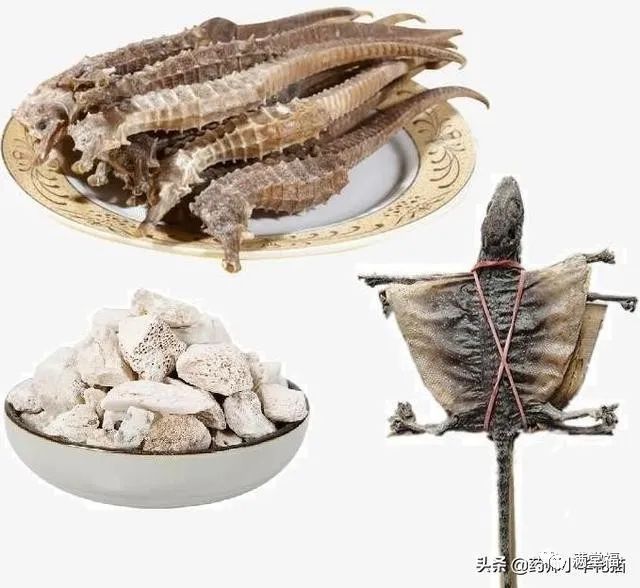
Illustration of medicinal materials: Seahorse, Gecko, and Dragon Bone.
7. Jiarong Tablets
Function and Indications: Nourishes Yin and supports Yang, tonifies the kidneys, and benefits essence. Used for menopausal syndrome with both Kidney Yin and Yang Deficiency, presenting with hot flashes, sweating, cold intolerance, and lower back and knee soreness.
Main Ingredients: Dipsacus, Rehmannia (cooked), Cinnamon, Aconite (processed), Goji Berries, Ligustrum (processed), Chinese Yam, Poria, Cuscuta (processed), Cistanche (processed), Peony, and Alisma.
Dosage: Oral administration, 0.23g/tablet, 4-5 tablets at a time, 3 times a day.
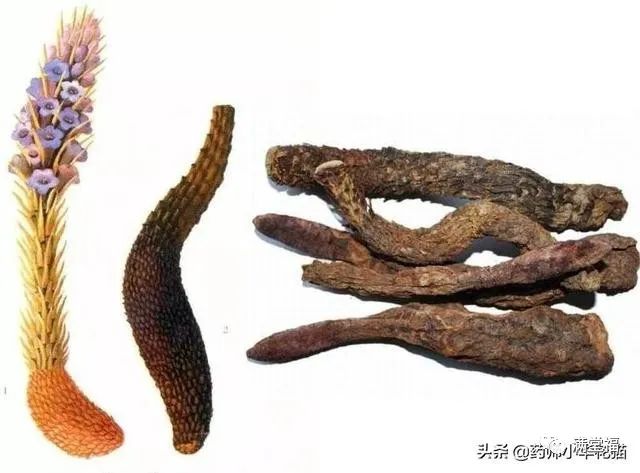
Illustration of Cistanche plant, with the right side showing dried Cistanche.
8. Lock Yang Kidney Nourishing Capsules
Function and Indications: Tonifies the kidneys, strengthens Yang, fills essence, and solidifies the true essence. Used for Kidney Yang Deficiency or Kidney Yin Deficiency leading to impotence, nocturnal emissions, and premature ejaculation.
Main Ingredients: Lock Yang, Xianmao, Morinda Root, Angelica, Cnidium, Cistanche (steamed), Chives, Schisandra (steamed), Red Ginseng, Bull Whip (processed), Dog Kidney (processed), Deer Antler, Black Shun Pian, Cinnamon, Fennel, Yangqi Stone (calcined), Pepper, Cuscuta, Eucommia (salted), Sand Yaozi (salted), Codonopsis (honey-fried), Cornelian Cherry (steamed), Epimedium, Astragalus (honey-fried), Chinese Yam, Rehmannia (cooked), Psoralea (salted), Goji Berries, Raspberry, Atractylodes, and Alisma.
Dosage: Oral administration, 10 capsules/pack, 3-5 capsules at a time, 2-3 times a day.
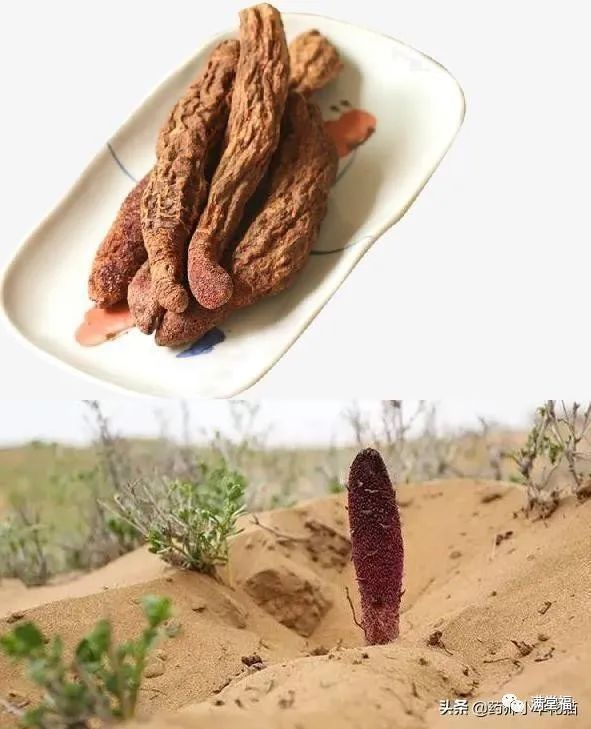
Illustration of medicinal materials: Lock Yang and its growth environment.
9. Qiang Kidney Tablets
Function and Indications: Tonifies the kidneys, fills essence, and benefits Qi and strengthens Yang. Used for both Yin and Yang Deficiency leading to kidney deficiency edema, lower back pain, nocturnal emissions, impotence, premature ejaculation, and frequent urination at night; chronic nephritis and persistent pyelonephritis with the above symptoms.
Main Ingredients: Deer Antler, Chinese Yam, Cornelian Cherry, Rehmannia (cooked), Goji Berries, Salvia, Psoralea, Peony, Mulberry, Motherwort, Poria, Alisma, Salted Eucommia, and Ginseng Stem Leaf Saponins.
Dosage: Oral administration, 0.63g/tablet, 2-3 tablets at a time, 3 times a day, with dosage adjusted for children.
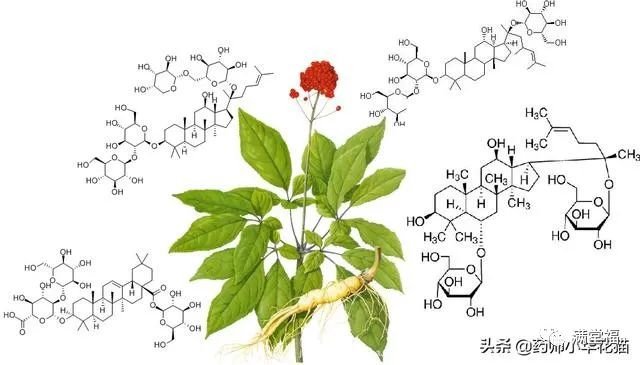
Illustration of several ginsenoside structures.
10. Buxin Pills
Function and Indications: Tonifies the kidneys and strengthens the body. Used for fatigue, dizziness, palpitations, and tinnitus.
Main Ingredients: Ingredients include bull testicles, horse testicles, sheep testicles, deer whip, donkey whip, hand ginseng, Polygonatum, and Goji Berries.
Dosage: Oral administration, 9g/pill, 1 pill at a time, 1 time a day, taken with boiled water before bed.

Illustration of hand ginseng and Polygonatum.
11. Shenrong Whip Pills
Function and Indications: Tonifies the kidneys, strengthens muscles, and increases essence. Used for decreased libido, Kidney Deficiency, weakness, impotence, premature ejaculation, and all kidney diseases in both men and women.
Main Ingredients: Deer Antler, Morinda Root, Cuscuta (roasted), Yangqi Stone (calcined), Black Shun Pian, Sand Ginger, Rehmannia (cooked), Codonopsis, and other ingredients.
Dosage: Oral administration, small pills of 10 grains at a time, 2 times a day, taken with light salt water or boiled water.
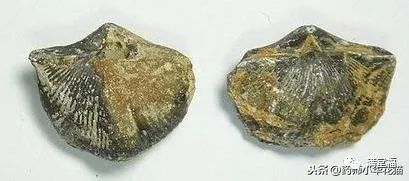
Illustration of Shiyan medicinal material.
Shiyan is a fossil of various closely related animals from the ancient class of brachiopods, including the Chinese bow stone and other similar animals. It has a sweet and salty taste, is cool in nature, and belongs to the kidney and bladder meridians. It has the effect of eliminating damp heat, promoting urination, and clearing eye obstructions. It is commonly used to treat gonorrhea, urinary obstruction, leukorrhea, hematuria, childhood malnutrition, intestinal wind, hemorrhoids, and eye obstructions.
12. Buxin Qiangshen Tablets
Function and Indications: Tonifies the kidneys and strengthens the body. Used for lower back soreness, weakness in the legs, dizziness, and tinnitus.
Main Ingredients: Epimedium, Cuscuta, Cornelian Cherry, Ligustrum, and Dog Spine (processed).
Dosage: Oral administration, 0.28g/tablet, 5 tablets at a time, 3 times a day.

Illustration of the original plant and slices of Dog Spine.
13. Waist Pain Tablets
Function and Indications: Strengthens the waist, tonifies the kidneys, invigorates blood, and alleviates pain. Used for Kidney Deficiency causing lower back pain and muscle strain.
Main Ingredients: Eucommia leaves (salted), Dipsacus, Dog Spine (processed), Achyranthes, Psoralea (salted), Earthworm (wine-fried), Frankincense (processed), Red Peony, Cinnamon, Alisma (roasted).
Dosage: Taken with salt water, 0.3g/tablet, 6 tablets at a time, 3 times a day.
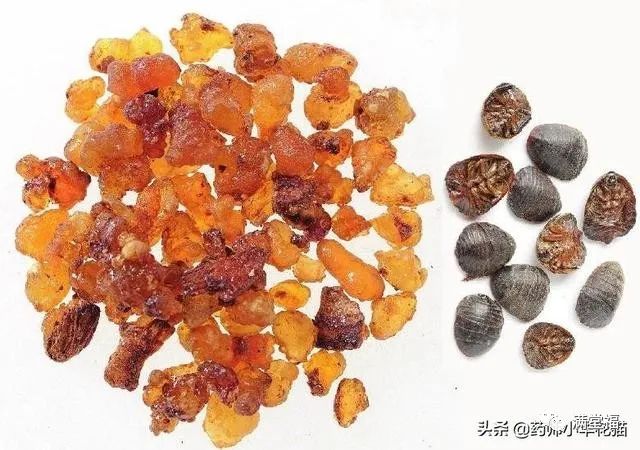
Illustration of Frankincense and Earthworm.
14. Yangchun Oral Liquid
Function and Indications: Tonifies the kidneys, generates essence, and benefits the brain. Used for insomnia, forgetfulness, and Kidney Deficiency causing lower back pain.
Main Ingredients: The main ingredients are Ginseng, Deer Antler, Epimedium (roasted), Cuscuta, Cornelian Cherry (wine-roasted), Yangqi Stone, and Black Chicken (feathers, claws, and intestines removed).
Dosage: Oral administration, 10ml (1 vial) at a time, 3 times a day; if there is a small amount of sediment, shake before use.
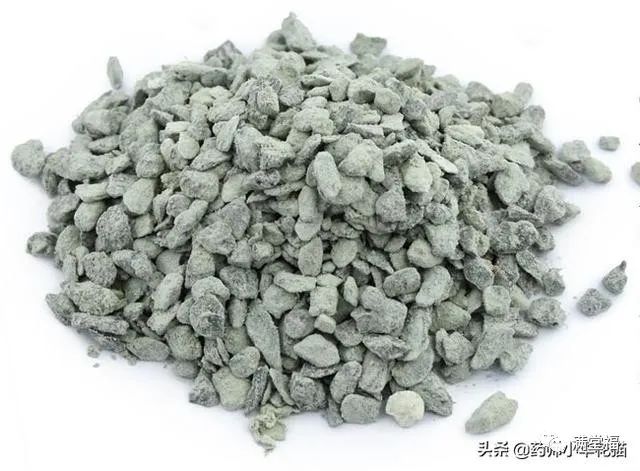
Illustration of Yangqi Stone medicinal material.
Yangqi Stone is a mineral from the silicate class, specifically from the amphibole group. It has a salty taste and is warm in nature. It belongs to the kidney meridian. It has the effect of warming the kidneys and strengthening Yang. It is used to treat Kidney Yang Deficiency, cold and numbness in the lower back and knees, impotence, infertility in women, and other related conditions.
15. Gui Lu Kidney Nourishing Tablets
Function and Indications: Strengthens muscles and bones, benefits Qi and blood, tonifies the kidneys, and strengthens Yang. Used for physical weakness, fatigue, lower back and leg soreness, dizziness, coldness in the kidneys, decreased libido, frequent urination at night, and forgetfulness.
Main Ingredients: Cuscuta (roasted), Epimedium (steamed), Dipsacus (steamed), Lock Yang (steamed), Sour Jujube Seed (roasted), Processed He Shou Wu, Honey-fried Licorice, Dried Tangerine Peel (steamed), Deer Antler Glue (roasted), Rehmannia (cooked), Turtle Shell Glue (roasted), Cornelian Cherry (steamed).
Dosage: Oral administration, 0.41g/tablet, 2-4 tablets at a time, 2 times a day.
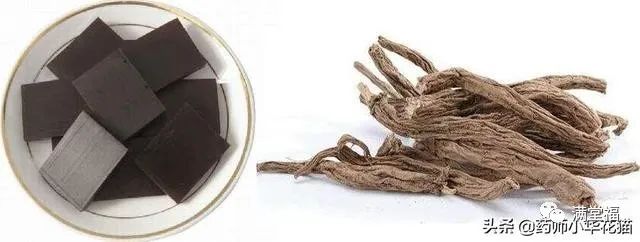
Illustration of Turtle Shell Glue and Dipsacus.
Many people often message me, warning me not to make spelling mistakes, saying I always write “症” as “证”. Today, I would like to address this matter:
“证” and “症” have completely different meanings in TCM theory:
“证” refers to syndrome, which is a comprehensive description of the cause, pathogenesis, affected area, nature of the disease, and the comparative strength of pathogenic and healthy forces during the development stage of a disease. For example, spleen and stomach deficiency syndrome, Qi and blood deficiency syndrome, Qi stagnation and blood stasis, Kidney Yin and Yang deficiency, etc., all fall under the category of syndrome.
“症” refers to symptoms, which are the external manifestations of the body’s response to disease and the subjective feelings of discomfort, such as dizziness, headache, nausea, vomiting, painful urination, cough, cold intolerance, etc.
In simple terms, “证” is determined by TCM practitioners through observation, inquiry, and examination in conjunction with your actual situation; “症” is what you can feel as discomfort.

I hope everyone stays healthy and energetic.

